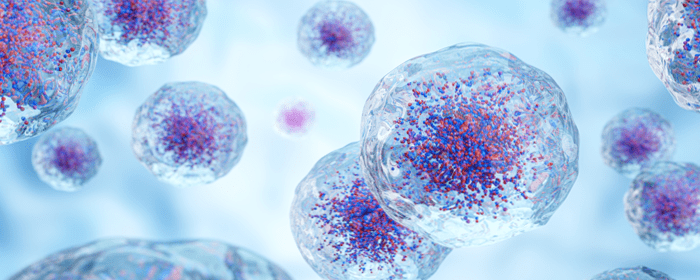
by admin | Mar 29, 2023 | Spinal Cord Injury, Mesenchymal Stem Cells, Regenerative Medicine, Stem Cell Research, Stem Cell Therapy
The National Institute of Health estimates that nearly 250,000 people in the United States are currently living with a spinal cord injury (SCI). Most often a result of an accident, SCIs typically result in the loss of neurons and axonal damage resulting in the loss of function.
SCIs can be divided into two distinct phases, the initial physical injury and the secondary injury which typically occurs hours to days later. In most cases of SCI, damage to the axonal and tissue damage is caused by compression and/or contusion to the spinal cord. The secondary SCI injury occurs in the hours and days after the initial injury and is characterized by persistent inflammation, glial scar formation, demyelination of surrounding neurons, and death of cells. Over time, research has demonstrated that, in all aspects of secondary injury, the inflammatory response is the major cause and leads to widespread cell damage and lesion expansion.
Recent research has demonstrated that stem cells, including mesenchymal stem cells (MSCs), neural stem/progenitor, and embryonic stem cells, possess anti-inflammatory properties and promote functional recovery after SCI by inducing macrophages M1/M2 phenotype transformation.
In this review, Cheng and He discuss the general feature of macrophages in response to SCI, the phenotype, and function of macrophages in SCI, and the effects of stem cells on macrophage polarization and its role in stem cell-based therapies for SCI.
Macrophages accumulate in and around an SCI and play a very important role in neuroinflammation. Considering that recent research demonstrates the different, but important, contributions M1 and M2 macrophages make toward repairing tissue damage, this process is thought to be a promising therapeutic treatment for controlling the inflammation occurring after initial SCI.
According to this review, there are both positive and negative effects of macrophages on tissue repair and regeneration after an SCI. Interestingly, some studies show that infiltrating macrophages has harmful effects, especially in the early stages of an SCI. On the other hand, studies also indicated that macrophages have beneficial effects on tissue repair. These results included findings indicating that activated macrophages could provide a beneficial microenvironment that is good for the regeneration of sensory axons.
While the exact reason for the opposite effects of macrophages on the pathological process of SCI is not yet known, it’s thought to be because of the different phenotypes of macrophages – M1 (classical activation) and M2 (alternative activation).
Additionally, studies have demonstrated that M2 macrophages are important for efficient remyelination after CNS injury, while M1 macrophages hinder neurogenesis and inhibit neurite outgrowth and induce growth cone collapse of cortical neurons.
Considering these findings, the authors point out that polarization of macrophages to M2 is beneficial – and often preferred to M1- to facilitate the recovery after SCI. These findings have also demonstrated stem cell transplantation to hold tremendous potential for therapeutic uses in the treatment/recovery after SCI.
There is accumulating evidence indicating that the current preference of M2 macrophages compared to M1 macrophages correlates with remission of SCI in cases receiving SCI interventions including anti-inflammatory therapies and stem cells. The authors of this review conclude that while the exact process by which stem cells regulate macrophage polarization has yet to be determined, stem cells can alter macrophage polarization and promote functional recovery postinjury.
Source: “Anti-inflammatory effect of stem cells against spinal cord injury via | JN.” 13 Feb. 2017, https://www.dovepress.com/anti-inflammatory-effect-of-stem-cells-against-spinal-cord-injury-via–peer-reviewed-fulltext-article-JN.

by Stemedix | Mar 27, 2023 | Regenerative Medicine
Arthritis is a common condition, and according to the World Health Organization (WHO), it is estimated that over 300 million people worldwide have some form of arthritis. In the United States, the Centers for Disease Control and Prevention (CDC) estimates that over 54 million adults have doctor-diagnosed arthritis, which represents over 23% of the adult population. Arthritis can affect people of all ages and genders, but it is more common in older adults and women. The prevalence of arthritis is expected to increase in the coming years as the population ages. So does Regenerative Medicine work for Arthritis? Keep reading to learn more.
Arthritis is a general term used to describe inflammation and stiffness of the joints. It can refer to a range of conditions that affect the joints, including osteoarthritis, rheumatoid arthritis, psoriatic arthritis, and gout, among others. Arthritis can cause pain, swelling, and difficulty moving the affected joint(s), and it can affect people of all ages and genders. Some types of arthritis are caused by wear and tear on the joints over time, while others are caused by autoimmune or inflammatory conditions.
Types of Arthritis
There are many different types of arthritis, and the causes can vary depending on the specific type. However, in general, arthritis is caused by inflammation and damage to the joints.
Osteoarthritis, which is the most common type of arthritis, is caused by the wear and tear on the joints that occurs with aging, as well as other factors such as obesity, injury, and genetics.
Rheumatoid arthritis, on the other hand, is an autoimmune disorder in which the body’s immune system mistakenly attacks the joints, causing inflammation and damage.
Other types of arthritis may be caused by infections, metabolic disorders, or other medical conditions.
In some cases, the exact cause of arthritis may be unknown. However, certain risk factors, such as age, family history, and obesity, may increase a person’s likelihood of developing arthritis.
Treatments for Arthritis
There are a variety of treatments available to help manage the symptoms of arthritis, and the specific treatment options will depend on the type and severity of the condition. Treatment options for arthritis may include medication, physical therapy, lifestyle changes, and, in some cases, surgery. Some common treatments for arthritis include:
Medications: Over-the-counter or prescription medications, such as nonsteroidal anti-inflammatory drugs (NSAIDs), corticosteroids, and disease-modifying antirheumatic drugs (DMARDs), may be used to reduce pain, inflammation, and joint damage.
Physical therapy: A physical therapist can work with patients to develop an exercise program designed to improve mobility and strength, and reduce pain.
Occupational therapy: An occupational therapist can teach patients how to modify daily activities to reduce stress on the joints and conserve energy.
Lifestyle changes: Losing weight, eating a healthy diet, and avoiding activities that exacerbate joint pain can help manage the symptoms of arthritis.
Assistive devices: Splints, braces, and other devices can help support and protect the joints, making it easier to perform daily activities.
Surgery: In some cases, surgery may be necessary to repair or replace damaged joints.
It’s important for individuals with arthritis to work closely with their healthcare provider to develop a comprehensive treatment plan that meets their unique needs and goals.
How Can Regenerative Medicine Help Arthritis?
So how does Regenerative Medicine work for Arthritis? A therapy option not in the mainstream of traditional medicine is regenerative medicine, also known as stem cell therapy. There is some evidence to suggest that stem cell therapy may be effective in treating arthritis, but more research is needed to fully understand its potential benefits and risks.
Mesenchymal stem cells (MSCs) are a type of adult stem cell that can differentiate into various types of cells, including bone cells, cartilage cells, and fat cells. MSCs are found in many different tissues throughout the body, including bone marrow, adipose tissue, and the umbilical cord.
MSCs have the ability to self-renew and differentiate into specialized cells, which makes them useful in a variety of medical applications, including tissue engineering and regenerative medicine. MSCs also have anti-inflammatory properties and can modulate the immune response, which makes them an attractive option for treating a variety of immune-mediated disorders.
Research into the therapeutic potential of MSCs is ongoing, and clinical trials are being conducted to investigate their potential in treating a variety of conditions, including arthritis, cardiovascular disease, and neurological disorders.
Stem cells have the ability to differentiate into different types of cells in the body, including cartilage cells. This has led researchers to investigate whether stem cell therapy could help repair damaged cartilage in patients with arthritis.
What Studies Have Been Done on Regenerative Medicine?
Some clinical trials have reported positive results, with patients experiencing reduced pain and improved function following stem cell therapy.
There have been several preclinical and clinical studies that have investigated the potential of mesenchymal stem cells (MSCs) for treating arthritis, and some have shown promising results. Here are a few examples:
A 2019 randomized controlled trial published in the journal Stem Cells Translational Medicine found that intra-articular injection of allogeneic MSCs was safe and effective in reducing pain and improving function in patients with knee osteoarthritis.
A 2020 systematic review and meta-analysis published in the journal Frontiers in Bioengineering and Biotechnology concluded that MSC therapy has the potential to provide a safe and effective treatment for osteoarthritis, although more well-designed clinical trials are needed to confirm its efficacy.
A 2021 study published in the journal Stem Cell Research & Therapy reported the results of a randomized, double-blind, placebo-controlled trial that investigated the safety and efficacy of intra-articular injections of autologous MSCs in patients with knee osteoarthritis. The study found that the treatment was safe and well-tolerated, and resulted in significant improvements in pain, function, and quality of life compared to the placebo group.
Another 2021 study published in the journal Clinical Rheumatology investigated the safety and efficacy of a combination therapy of intra-articular injections of allogeneic MSCs and hyaluronic acid in patients with knee osteoarthritis. The study found that the combination therapy was safe and resulted in significant improvements in pain, function, and quality of life compared to a control group.
A 2022 study published in the journal Stem Cell Research & Therapy investigated the safety and efficacy of intra-articular injections of umbilical cord derived MSCs in patients with knee osteoarthritis. The study found that the treatment was safe and well-tolerated, and resulted in significant improvements in pain, function, and quality of life compared to a control group.
So to answer the question of ” Does Regenerative Medicine Work for Arthritis ” the answer is…Overall, these studies suggest that MSC therapy may be a promising treatment option for arthritis. Many patients are exploring stem cell therapy as an option in their healing journey along with other natural and traditional medicines. If you would like to learn more about the regenerative medicine options for Arthritis, contact us today at Stemedix!

by admin | Mar 22, 2023 | Stem Cell Research, Mesenchymal Stem Cells, Stem Cell Therapy
Currently, it’s estimated that over 1.3 million people in the U.S., and 10 million people around the world, are living with inflammatory bowel disease (IBD). IBD is a chronic and recurrent disease characterized by inflammation of the tissues of the digestive tract[1]. Two specific diseases included under the term IBD include Crohn’s disease (CD) and ulcerative colitis (UC).
While the exact cause of IBD has yet to be determined, research seems to suggest abnormal activation of the immune system, genetic susceptibility, and altered intestinal flora resulting from mucus barrier defects play some type of role in the pathogenesis of this disease. Currently, a complete IBD treatment or cure exists. Recent research has also demonstrated that adults with IBD are more likely to suffer from other chronic conditions, including diabetes, arthritis, lung cancer, and heart disease[2].
Clinical trials using stem cell therapy have demonstrated promising results for the potential treatment of IBD, including long-term remission in some patients.
In this review, Zhang et al. review the upcoming stem cell transplantation methods for clinical application and the results of ongoing clinical trials exploring the use of stem cell transplantation as a potential treatment for IBD.
Specific stem cells, known as hematopoietic stem cells (HSC), have been shown to be particularly effective when used as a therapeutic treatment. HSCs are isolated from blood, bone marrow, and cord blood that migrate directly to damaged mucosal tissues. Initially used in patients with IBD because of other hematologic indications, including leukemia and non-Hodgkin’s lymphoma, the use of HSC therapy (HSCT) demonstrated improvement in intestinal lesions. Further study using HSCT showed that some patients with UC and CD demonstrated sustained clinical and endoscopic improvement. The authors point out that while these limited clinical trials have demonstrated promising results, the observed risk of relapse currently prevents HSCT from being classified as an effective treatment and calls for larger samples and longer-term efficacy observations.
Another stem cell treatment currently being evaluated for the treatment of IBD is the use of mesenchymal stem cells (MSCs). When injected intravenously, MSCs demonstrate the ability to reach the injured area of the intestine, colonize mucosa to control inflammation, improve microcirculation, and repair damaged tissues. A systematic review conducted by Lalu et al. found that the use of MSCs did not show significant side effects and was a relatively safe therapeutic treatment option.
Zhang et al. conclude that the significant advance in stem cell research made over the past twenty years has made them a promising therapeutic option for the treatment of IBD. Although a limited number of clinical trials have confirmed the efficacy of specific stem cells, specifically HSC and MSCs in IBD, the authors point out that the current treatments need to be improved and further research must be conducted in order to fully understand the complexity associated with the condition.
While this review focuses primarily on the use of HSC and MSC, Zhang et al. call for continued preclinical exploration of other cell therapy methods with the goal of improving the quality of life of IBD patients.
Source: “Stem Cell-Based Therapies for Inflammatory Bowel Disease – PMC.” 31 Jul. 2022, https://www.ncbi.nlm.nih.gov/pmc/articles/PMC9368934/.
[1] “Inflammatory bowel disease (IBD) – Symptoms and causes.” https://www.mayoclinic.org/diseases-conditions/inflammatory-bowel-disease/symptoms-causes/syc-20353315.
[2] “People with IBD Have More Chronic Diseases – CDC.” https://www.cdc.gov/ibd/features/IBD-more-chronic-diseases.html.

by Stemedix | Mar 20, 2023 | Back Pain
Lower back pain is a common condition that affects millions of people worldwide and can be caused by several factors. It is estimated that about 80% of adults will experience lower back pain at some point in their lives. Here we will discuss how to relieve lower back pain.
While some cases of lower back pain are mild and can be easily treated at home, others may require medical attention. If you are experiencing lower back pain, it is important to seek a medical evaluation to determine the underlying cause so an appropriate treatment plan can be developed to help relieve symptoms.
Causes of Lower Back Pain
Lower back pain can be caused by several factors, including:
- Poor Posture: Sitting or standing for long periods in the wrong posture can cause lower back pain.
- Injury: An injury to the lower back, such as a sprain or strain, can cause pain.
- Herniated Disc: A herniated disc can cause lower back pain by pressing on the nerves in the lower back.
- Arthritis: Arthritis can cause inflammation in the joints of the lower back, leading to pain.
- Osteoporosis: Osteoporosis weakens the bones in the spine, making them more prone to fractures.
Symptoms of Lower Back Pain
- Lower back pain can manifest in various ways, including:
- Dull or sharp pain in the lower back.
- Pain that radiates to the legs.
- Stiffness in the lower back.
- Numbness or tingling sensation in the legs.
- Weakness in the legs.
Relief Options for Lower Back Pain
Exercise: Exercise is an important part of managing low back pain. Regular exercise can help strengthen the muscles that support the lower back, improve flexibility and range of motion, and reduce the risk of future injuries.
Stretching: Gentle stretching can help relieve tension in the muscles and alleviate pain. Remember to listen to your body and move slowly and gently, especially if you’re experiencing pain.
Heat Therapy: Also known as thermotherapy, this therapy can help to relax muscles and increase blood flow to the affected area, which can be helpful in reducing muscle tension and stiffness.
Cold Therapy: Also known as cryotherapy, this therapy can help reduce inflammation and swelling. It can be most helpful in the first 48-72 hours after a back injury using the 20 minutes on and 20 minutes off timing method.
Medications: Over-the-counter pain relievers such as ibuprofen, aspirin, or acetaminophen can help alleviate pain. Be sure to speak to your healthcare provider on which options are best for you.
Massage Therapy: Massage therapy can be an effective treatment option for lower back pain, as it can help to relax tight muscles, increase circulation, and reduce inflammation. However, it’s important to note that massage therapy should be used in conjunction with other treatments and under the guidance of a healthcare professional.
Chiropractic Care: Chiropractic care involves the manual manipulation and other techniques to help alleviate pain, improve mobility, and restore function.
Regenerative Medicine for Lower Back Pain
Regenerative medicine is a rapidly growing field of medicine that focuses on inflammation and the repair and regeneration of damaged tissues. In recent years, regenerative medicine has shown promise in the treatment of lower back pain. There are several regenerative medicine techniques that are being used to treat lower back pain, including:
Platelet-rich plasma (PRP) therapy: PRP therapy involves injecting a concentrated dose of platelets, growth factors, and other healing factors derived from the patient’s own blood into the damaged area of the lower back. These growth factors promote tissue repair and regeneration, reducing inflammation and pain.
Stem cell therapy: Stem cell therapy involves injecting stem cells derived from the patient’s own bone marrow or adipose tissue into the damaged area of the lower back. These stem cells have the ability to differentiate into various types of cells, including bone, cartilage, and muscle cells, which can help repair and regenerate damaged tissues.
Prolotherapy: Prolotherapy involves injecting a solution of dextrose or other irritants into the damaged area of the lower back. This solution stimulates the body’s natural healing process, promoting tissue repair and regeneration.While regenerative medicine techniques have shown promise on the effectiveness and safety for treatment of lower back pain, research will continue to help build on this foundation of studies. It is also important to note that these treatments may not be appropriate for all patients and should only be performed by trained medical professionals. If you are experiencing lower back pain, it is important to speak with your healthcare provider to determine the best course of treatment for your specific condition.
by Shoot To Thrill Media | Mar 15, 2023
Our Doctors Dr. Adam Gorberg, MD Dr. Adam Gorberg is board certified by the American Board of Anesthesiology. He began his studies at the State University of New York at Albany, graduating Summa Cum Laude with Bachelor of Science degree in Biology. He received his...





 St. Petersburg, Florida
St. Petersburg, Florida
